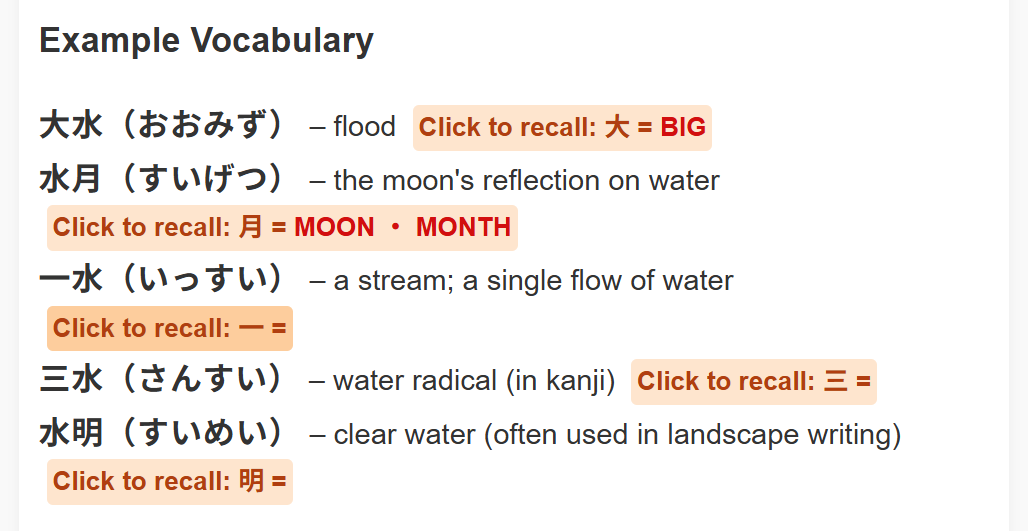The Two-Phase Approach
Why We Split Kanji Mastery Into Two Sweeps

Mastering kanji can feel overwhelming—thousands of characters, each with multiple readings, stroke orders, meanings, and example words. Where do you even start?
Here’s the secret: Don’t try to do it all at once. The Kanji Speedrun uses a “two-phase” method to break the mountain into two friendly hills: Phase 1 and Phase 2.
⏩ Phase 1: Meaning & Recognition First

- Focus only on the meaning of each kanji (with help from a vivid mnemonic and story illustration—Ken & Mei are here to help!).
- Don’t stress about the readings or stroke order—those will come later!
- Practice "active recall" with toggles and review sheets—see if you remember the meaning before you check the answer.
- Review using our 5-day review system: check off a box for each correct recall, one per day.
Why? Because recognition is what unlocks the world—books, apps, signs, manga, JLPT exams. Meaning is the foundation.
💡 Phase 1 in Action
- Each kanji page introduces the core concept and gives you a memorable mnemonic, story, and example vocab that re-uses what you already know.
- Our toggle system lets you test your memory in a “quiz mode”—meanings are hidden until you click.
- Each chapter ends with a review sheet to help you identify which kanji are sticky and which need more practice.

If you’d like to begin Phase 1, head over to the Start Here page.
🔁 Phase 2: Readings, Writing & Mastery

- Now it’s time to tackle readings, stroke order, and writing.
- You will go through a separate course on the site called "Phase 2". Think of it almost like the second book in a two-part series.
- You'll go back through each kanji. This time, you’re not a beginner—you recognize all of them, so learning to write and pronounce them will be much easier.
- Practice writing (and reading out loud!) full wordsーby hand, with Anki, or even better, with Skritter.
- Build your vocab by learning example words that connect kanji to real Japanese.
Why split it? Trying to learn all meanings, readings, and how to write at once overwhelms most learners and kills motivation. But by separating them, you are able to progress quickly and easily.
You can check the Phase 2 page to see updates on its development.
✨ Why This Method Works
- Recognition is fastest to learn and most rewarding.
- Writing and readings “stick” better after you’ve already seen a kanji dozens of times out in the wild.
- When you split your learning into two passes, you never get bogged down—you always know what to focus on next.
- You start reading Japanese *much* sooner! By focusing on meanings first, you unlock books, manga, websites, and street signs much, much sooner.
- Crush the JLPT—faster. Meaning-first mastery means you can blaze through the kanji requirements for N3, N2, or even N1 in a fraction of the time. No more getting stuck memorizing lists or endless writing drills.
This two-phase approach—focusing on recognition and comprehension before production—follows modern language learning research and proven teaching practice. See Paul Nation’s summary of The Four Strands or Tofugu’s article Focus Is On Reading, Not Writing for more background. My own experience as a teacher has shown that students make faster, longer-lasting progress when they follow this order.

🌱 A Real-Life Example: Meet Ken & Mei


On The Kanji Speedrun, you’re never alone—Ken & Mei are your guides!
- Phase 1: Ken & Mei walk you through vivid mnemonic stories, helping you lock in each core meaning (with illustrations and simple quizzes).
- Phase 2: They come back to introduce you to writing, readings, and real-world usage, step by step.
Think of the second pass as “leveling up”—your building a bigger, more study "house" on the strong foundation you set.
📊 How Do I Know When I’m Ready for Phase 2?
Simple: once you’ve finished the *first pass* through all chapters, and you feel confident with the meanings and recognition, you’re ready to start writing and reading practice.
- If you can recognize 88-92% of the kanji in the course, it's time!
- If you want more review, just spend a little more time with your Anki decks.
- Remember: there’s no “perfect” time—just keep moving forward.
🏆 The Benefits: Speed, Motivation, & Mastery
- Phase 1 builds speed and reading confidence—great for JLPT, manga, apps, or daily life.
- Phase 2 adds depth: real literacy, writing, and natural usage.
- You’ll avoid the burnout and overwhelm that come from trying to do it all at once.
Ready to stop reading about kanji—and start learning them?
Curious about plan options? Click here.
Want to read about my learning journey and philosophy? Click here.